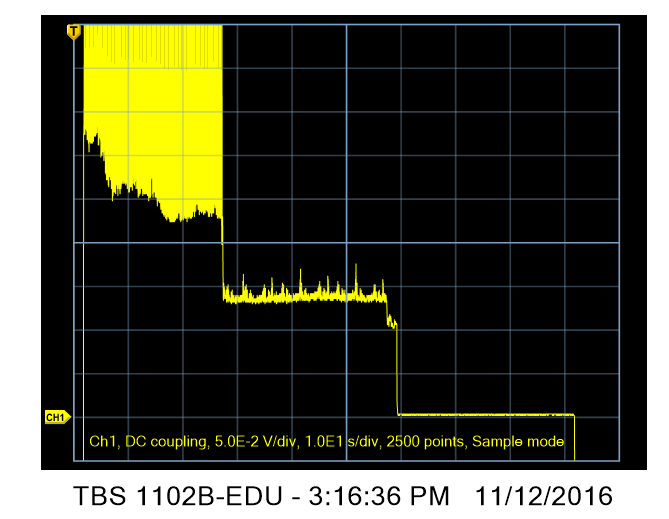This is an afterthought to a series of posts on power consumption in the Sony a7RII. The more recent incarnation of the series starts here.
There have been some questions about the current draw of smart adapters on the a7RII. I happen to have a Vello LAE-SE-NFV4 Nikon F to Sony E adapter that I use to control the aperture of Nikon E-series lenses mounted on a7x cameras. This is a rebranded Commlite adapter.
When I mounted the adapter and no lens, both the startup and the shutdown timing were affected. Here’s a distinctly abnormal shutdown:
The time base is 10 seconds per division. The camera was turned off at about division 0.4. The scanning stays active for more than 20 seconds, then the camera drops to a state where the current draw is in the 300 milliamp region for another 30 seconds before shutting down. When shutdown occurs, the currents are the same as with a dumb adapter or with a Sony native lens: 5.25 ma for a minute or two, followed by 1.34 ma for days (I assume in this case it is days; I can say for sure that it lasts at least 8 hours).
However, when I mounted a Nikon 85mm f/1.4 G lens to the Vello adapter and powered down the camera, the current dropped first to 8.27 ma, then, after a minute or two, to 4.23 ma. It stayed at 4.23 ms for at least 8 hours.
So, Vello users, be very careful about leaving your Nikon lenses and the adapter attached to the camera when you put it away. The battery will drain about three and a half times as fast as normal.
Users of other smart adapters might want to do their own testing.
Caveat: this adapter was purchased from Amazon in February of this year, and it still has the firmware with which it was shipped.
The adapter did draw more current when autofocusing than the Batis 85/1.8 native lens, but the effect was not unduly large. It’s hard to set up an experiment to make apples-to-apples measurements of this. This is not a review of the adapter, but you should know that the Batis 85 focuses much faster than the Nikon 85/Vello combination.

Leave a Reply